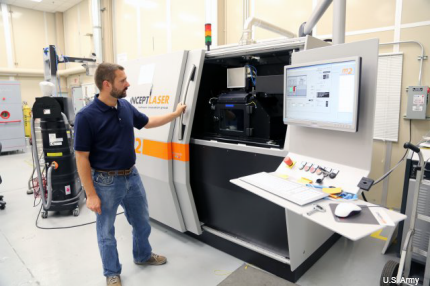Army, NASA explore new frontiers in 3D printing
An integrated product team, also including a university, will look to advance the state of the art of additive manufacturing.

AMRDEC engineer Lance Hall spent six months working in the Additive Manufacturing Lab at Marshall Space Flight Center.
The Army is looking to expand the possibilities for 3D printing by partnering with NASA and the University of Alabama in Huntsville to share ideas and advance the state of the art.
The Army’s Aviation and Missile Research Development and Engineering Center, NASA's Marshall Space Flight Center and UAH have formed an Additive Manufacturing Integrated Product Team to explore the latest advancements in the technology, the Army said.
3D printing, more accurately called additive manufacturing, uses computer-generated three-dimensional designs and a layered, or additive, process similar to that of ink jet printing to “print” 3D objects. The inks in the process can be liquid, powder, metal or paper.
"When you come to learn and appreciate the potential of AM, it's hard not to judge this as a true game-changer; one that will ultimately have far reaching, historical impacts onto our society at-large," said acting James Lackey, AMRDEC’s director.
NASA and the Army already have established track records to build on with the new partnership. The Army has put 3D printing to such uses as producing equipment in mobile laboratories in Afghanistan and repairing damaged aircraft and ground vehicles in the field. Researchers at Picatinny Arsenal, N.J., also are moving into printing electronics, such as antennas that can be printed onto helmets and sensors that can be embedded in clothing.
NASA, meanwhile, is taking 3D printing into space. The agency already has tested 3D-printed rocket engine components and parts, plans to 3D print food in space and has demonstrated how 3D printing can work in zero gravity.
Next up: The first 3D printer will be launched into space in August for trials on the International Space Station, where it will be used at first to tools and parts.
"Additive manufacturing is a step toward the future," said Dr. Dale Thomas, associate director, technical, at Marshall. "It is changing the way organizations design and manufacture products around the world, and space is one of the key places where humanity will see the impact of this technology."
NEXT STORY: Could smarter robots turn against their masters?